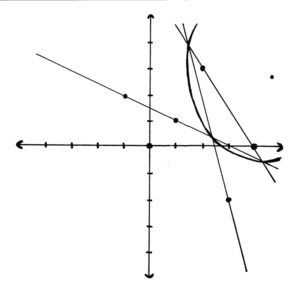
We’re trying to find the centre of a circle given the radius, a point on its circumference, and a point on a line that intersects 2 lines on its circumference. We already know one of the intersections. Since it takes 2 points to define a line, we can define 2 of the lines and find their intersection at (4.5, -0.75). Now, to find the centre of a circle, we draw the perpendiculars of 2 of the lines between the 3 points we are defining it with. Their intersection is the centre. We can use the 2 lines we know! That way, we know the slopes. Finding the intersection of 2 lines in y=mx+b form is easy peasy! x=(b1-b2)/(m2-m1), and y = m1x+b1. No problem. For the perpendiculars, we need the midpoints of the lines between intersections. No problem either, x = (x1+x2)/2, and y = (y1+y2)/2. To get a line given it’s slope and a point it passes through, we use b=y-mx. The slope is -1/m, where m was the old slope. The distance between 2 points is √((x1-x2)2+(y1+y2)2). Put all these simple things together and the answer should be easy. Let the slope of the line be x. Plugging x in through these equations gives the big equation below. A little bigger than expected. It equals 5 when x≈-2.954 and x≈-0.2364. These give the centres (5.503, 4.419), and (9.185, 0.9967).
\sqrt{\bigg(-{33x+166\over8(2x+3)}-2.053125\bigg)^2+\bigg(-{51x+214\over4(2x+3)}-{2x+3\over2x-3}-5.98125\bigg)^2}